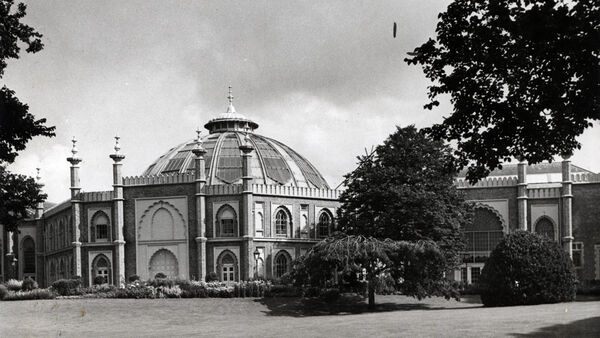Brighton Dome’s Corn Exchange and Studio Theatre prepare for return of live performance following major refurbishment
4 Oct 2023
Brighton Dome’s historic Grade I and Grade II listed Corn Exchange and Studio Theatre will officially reopen for live performances from November, following a six-year major capital refurbishment. The project includes substantial restoration and upgrades to both venues, including conserving vital heritage features for future generations and improving the visitor experience and facilities for artists and audiences alike.
The refurbishment is the first phase of a regeneration project by Brighton & Hove City Council, in partnership with Brighton Dome & Brighton Festival and Brighton & Hove Museums, to cement the Royal Pavilion Estate as a landmark UK destination for heritage and the arts. The circa £38 million project has been realised with support from Arts Council England, The National Lottery Heritage Fund and Coast to Capital Local Enterprise Partnership, alongside trusts and foundations and many individual donors.
The refurbished spaces have been designed by award-winning architects Feilden Clegg Bradley Studios (FCBS) with a primary focus on ensuring the buildings are energy efficient and environmentally sustainable. FCBS have sought to reduce carbon impact by using responsibly sourced construction materials wherever possible, including 6500 linear metres of sustainable European oak cladding that lines the Corn Exchange walls and dormer roof arches.
To further reduce energy consumption, parts of the existing fabric of the building has been improved to reduce heat loss and air infiltration. Front of house foyer spaces are naturally ventilated and in the event spaces, where mechanical ventilation provides user comfort, heat recovery systems are in place to reduce the overall energy use.
Lighting energy is also reduced through the use of LED lighting alongside automatic switches to control lighting in spaces when unoccupied. A newly-installed glass atrium in the middle of the building also provides a welcome natural light source during the day. Gas has been removed from kitchen areas, for more efficient and cleaner operations, and water usage and wastage is minimised via low flow sanitaryware fittings and automated controls.
Other innovations include state-of-the-art production technology installed throughout Brighton Dome, including the latest 5G technology which allows experimentation for live collaboration and performance across multiple locations and platforms.
The building now also contains a brand new dedicated creative space called Anita’s Room, which can accommodate up to 40 people and is fully equipped with a lighting grid and mixing desk. Supporting works in progress, small scale performances and events, Anita’s Room will be made available to Brighton Dome associate artists, resident artists, visiting performing artists, community projects and creative learning organisations. The space is named in memory of Dame Anita Roddick, the activist, entrepreneur and founder of The Body Shop and is made possible following a generous grant from The Roddick Foundation.
Other improvements include an increased audience capacity in the Corn Exchange, a new balcony seating area in the Studio Theatre and two new bars and a restaurant, supported by Foyle Foundation and Garfield Weston Foundation, providing more spaces for audiences to relax before or after a show. There are also new and improved backstage facilities for performers, supported by the Backstage Trust.
Brighton Dome’s rich history spans more than 200 years. The main Concert Hall and Corn Exchange were originally commissioned as a stable block and riding house by the Prince Regent in 1803, while the Studio Theatre was first built as a supper room during architect Robert Atkinson’s Art Deco refurbishment of the venue in the 1930s.
The architects and contractors have worked painstakingly to preserve the beauty and legacy of these historic buildings for everyone to enjoy. The original wooden beams of the Corn Exchange’s unique 18 metre single span timber frame – the widest in the country – have been repaired, strengthened and restored to designs created by the building’s original architect, William Porden in the early 1800s. During the restoration, Roman numerals interpreting Porden’s plans were found carved into the wood by carpenters who would have had the skilled task of assembling the heavy beams into the roof. Additionally, 34 pilaster columns have been recreated from 200-year-old archive drawings and on the roof, 16,000 Welsh slate tiles have been replaced, weighing 55 tonnes. With support from American Express Foundation, The Leche Trust, Pilgrim Trust, Regency Society and Wolfson Foundation, 11 beautiful arched windows have also been lovingly restored by hand.
The Studio Theatre’s original features, such as the crenelated windows which mimic the character of the Royal Pavilion, have been carefully conserved and its ceiling replaced with a new yet historically accurate version. Its exterior has been restored and repaired by numerous skilled craftsmen and the original copper roof has also been replaced to protect the interior of the building for years to come. In a nod to its history as a supper room, the ground floor has been transformed into a bright, contemporary all-day restaurant, run by award-winning, community-focused local company Redroaster. The Studio Theatre renovation has been supported by The Pebble Trust.
For the new Gallery Bar, architectural design studio Drinkall Dean have used the Corn Exchange’s original purpose as a riding house as the inspiration for decoration. A spectacular horse sculpture by West Sussex-based artist Graham Heeley is suspended in the atrium and an interactive digital timeline, from digital designersSquintOpera, allows visitors to explore Brighton Dome’s rich heritage - from the early 1800s to the present day. Downstairs, the wallpaper in the Festival Bar has been inspired by the artwork from Brighton Festival’s inaugural 1967 poster using imagery from artist Mike McInnerney, who has designed album covers for The Who, who formed part of the 1967 Festival line up.
The reopening of the Corn Exchange and Studio Theatre will offer an even wider and more accessible arts and community events programme for audiences and participants. The spaces have already welcomed 75,000 visitors to inaugural event Van Gogh Alive, a groundbreaking immersive exhibition that ran across the summer months.
From November onwards, the Corn Exchange and Studio Theatre will welcome back a wide range of live performance, including international dance companies, touring theatre productions and community events. It will also provide a platform for exceptional musical talent of all genres, from emerging regional talent to some of the industry’s most celebrated artists and orchestras. Both spaces will also return as core venues for the annual Brighton Festival in May, showcasing new and world-class art and performance.
Creating ever more inclusive spaces has been a top priority for the refurbishment, with improved access for visitors, staff and performers, including new accessible toilets and modern hearing assistance systems. A public lift provides wheelchair access to all levels of these historic buildings, along with low-level service counters provided at the bars. Crucial improvements backstage include more accessible dressing rooms and increased accessibility to backstage areas, making it easier for D/deaf, blindand partially sighted and disabled performers to take their places on the stage. These improvements have been made possible with support from Bruce Wake Charitable Trust, The Chalk Cliff Trust, Ernest Kleinwort Charitable Trust, The Lawson Trust and The Rampion Fund at Sussex Community Foundation.
The return of two major performance and community venues to the heart of Brighton & Hove signals the importance of arts and culture to the city and adds vital infrastructure to its creative sector. Once all phases of the project are complete, the Royal Pavilion Estate is estimated to welcome over 1.5million visitors, support over 1,200 jobs and have an economic impact of £68m, making it a significant cultural landmark in the UK.
Andrew Comben, Chief Executive of Brighton Dome & Brighton Festival, said:
“Brighton punches above its weight as a city and its thriving cultural and creative sector is a huge part of that success. Restoring these wonderful historic buildings to make them more open to residents and visitors, more useful to the city and its artists, more creative and more sustainable has been a labour of love for the project team and all of us at Brighton Dome & Brighton Festival.
“Our heartfelt thanks to Brighton & Hove City Council for preserving the city's world renowned heritage assets in a way that ensures they can be used and enjoyed by everyone for the next 200 years, and to all our funders and supporters: Arts Council England, The National Lottery Heritage Fund, Coast to Capital and the many Trusts & Foundations, individuals and businesses who have played such a vital part in bringing this project to fruition. We have come together believing in the central importance of arts and culture to Brighton & Hove's identity, its economy and its social wellbeing and it is our enormous privilege now to open our doors and share the stories these beautiful buildings hold already and those yet to be written.”
Bella Sankey, Leader ofBrighton & Hove City Council, said:
"The restoration of Brighton Dome’s much loved Corn Exchange and StudioTheatre has been one of the most important and ambitious projects undertaken in the city during recent years and reflects our commitment to protecting and preserving our precious historic buildings.
“The immersive Van Gogh exhibition, held over the summer, gave us our first glimpse of the beautifully restored buildings, which have also been enhanced to provide fantastic new and modern spaces, offering huge potential for culture and the arts to continue to flourish in the city.
“The restoration mixes old and new and provides fascinating historical insight into Brighton Dome through the ages. From a royal riding house to a skating rink, to a centre of suffragette action, Brighton Dome has long been the beating heart of Brighton and this can now continue into the future.
“Restoring these unique buildings has been a huge and complex undertaking and we are grateful to The National Lottery Heritage Fund, Heritage Capital Kickstart Fund and Arts Council England’s Cultural Capital Kickstart Fund for providing financial support, in addition to the main grant funding, and to Coast to Capital which has helped to make this possible.”
Hazel Edwards, South East Area Director, Arts Council England, said:
"Arts Council England has always been a proud supporter of Brighton Dome's vision to restore these buildings, a relationship that began with our first grant made in 2012. It's fantastic that these spaces can now be enjoyed by everyone, something which should be truly celebrated and is a tribute to the tenacity and persistence of all involved. I can't wait to see what cultural and creative experiences these spaces can play host to."
Stuart McLeod, Director of England - London & South at The National Lottery Heritage Fund, said:
“Investing in heritage means investing in the community it belongs to, which is why we are proud to support Brighton & Hove City Council with this project to restore the nationally important Corn Exchange and Studio Theatre on the Royal Pavilion Estate. Thanks to National Lottery players, this will not only preserve this important heritage to be enjoyed by locals and visitors from further afield, but it will also play a significant role in boosting the local economy and aiding the wider regeneration of Brighton.”
Peter Clegg, Founding Partner, Feilden Clegg Bradley Studios said:
“Seeing the building open to the public begins the next chapter for this magnificent Regency building, having upgraded and restored the buildings to provide a really dynamic cultural offer for the city and the region. What appealed to us most when we started the project was the Corn Exchange building itself. The original riding stables were one of the Prince Regent’s first buildings in Brighton and is still the widest single-span timber building in the country. Seeing the space now - fully restored, with all the layers that have been added over the years stripped out - you can see what an amazing building it is. But more than that, along with the renovated 1930s Studio Theatre, a new foyer and an upgraded technical installation for all kinds of performance events, Brighton Dome and Corn Exchange is an extraordinary venue for Brighton.”
For more details visit brightondome.org
Contact Us
For media enquiries please email us, or for URGENT enquiries please call us.

Brighton Dome celebrates its creative history with tours, talks and family friendly events at Heritage Open Day

Brighton Dome’s Access Open Day: Creative Roots Spotlights Disabled and Neurodivergent Artists and Careers

